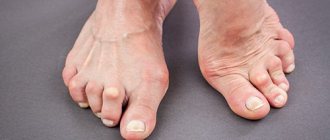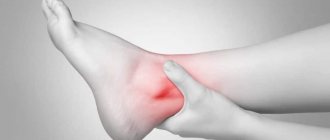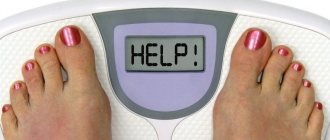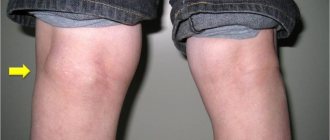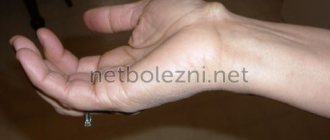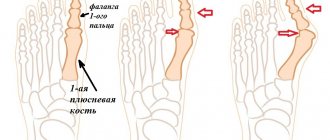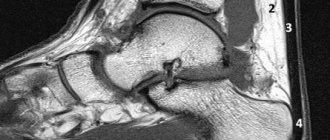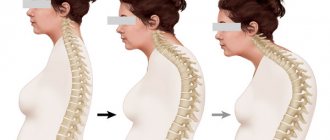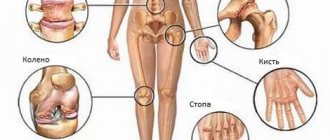Hygroma of the ankle gives a person a lot of unpleasant sensations. With this disease, difficulties arise when walking and wearing shoes. The first signs of the development of the disease are a reason to consult a specialist in view of the possible development of adverse consequences.
Hygroma is a tumor-like formation. Consists of a solid shell and liquid contents. It is benign in nature.
On the ankle, located next to the joint. It is more often diagnosed in the fair sex.
A cyst on the ankle is not dangerous. With small tumor sizes, the disease is asymptomatic. An enlarged hygroma interferes with a normal lifestyle. Bumps always need to be treated since they do not resolve. Hygromas do not degenerate into a malignant form.
Causes of development of ankle hygroma
The tendency to form hygromas can be transmitted from mother to child along a hereditary line
Hygroma of the ankle develops against the background of constant stress and injuries to this joint. The tumor can act as a kind of complication of arthrosis or inflammation of the tendons. Such tumors are often hereditary and can be a family disease.
At the same time, doctors were unable to identify one reason for the development of this disease. It is believed that ankle hygroma occurs under the influence of several factors. Among them:
- joint injuries;
- being overweight;
- excessive physical activity;
- joint diseases;
- genetic predisposition.
The development of hygroma of the ankle joint is often associated with injury. The tumor forms in the connective tissue and often occurs when the tendons and joint capsule are injured, for example due to compression or impact.
Another reason for the development of pathology is advanced joint diseases, for example, arthritis or arthrosis. Cysts also appear during a low-grade inflammatory process in the joint capsule or tendons.
Excess weight increases the load on the ankle joint. This increases the risk of injury, after which hygromas form. Thus, overweight people can be considered at risk of developing cysts in the joints.
Definition
Hygroma is a cystic benign neoplasm that consists of a dense membrane and liquid serous contents. The fluid contains the protein fibrin and mucus, which is why the filling cyst may have a jelly-like shape. Hygroma on the ankle is localized near the joint and is most often found in women. Hygroma, as a rule, does not pose a serious danger. The disease can be asymptomatic for a long time until the tumor grows to a noticeable size, in which case it begins to prevent the patient from walking, problems with choosing shoes and constant pain arise. Such a tumor cannot resolve or become malignant and become cancer, so the prognosis is always favorable.
Clinical picture
If any strange lump occurs on your leg, you should immediately go to the hospital
With hygroma of the ankle joint, a small tumor forms. Most often it is localized just above the bone on the foot, but in general it can appear on any part of the joint.
Hygroma of the ankle is equally common in children and adults. Women of any age are more likely to experience this pathology than men.
The tumor develops slowly, gradually increasing in size. At the initial stage, it appears as a small bump on the ankle. The skin in the area of the cyst is not changed, there is no discomfort when pressing or pain. Over time, the tumor increases in size, which is accompanied by changes in the epidermis. The skin may turn red, pale, or peel. With frequent squeezing of the hygroma, the skin in this area acquires a bluish tint.
Normally, a hygroma on the ankle in the area of the bone does not hurt. If it forms in a place with a large number of nerve endings, a pain syndrome appears that increases with pressure. Pain can also occur with large hygromas that compress the nerve endings.
Thus, hygroma of the right or left ankle joint has the following typical symptoms, thanks to which it can easily be recognized independently:
- lump on a bone;
- rapid increase in tumor size;
- discomfort when compressed by shoes;
- pain when pressing;
- skin changes (not always).
Even if the hygroma does not hurt, it is recommended to consult a doctor and undergo examinations to exclude other pathologies of the joint, including advanced inflammatory diseases that occur in subacute or chronic form.
Symptoms of ganglion or hygroma
- a tumor or ball that is soft to the touch, which can either increase or decrease;
- sudden swelling in the area of the hygroma;
- hygroma may appear and disappear again for a while;
- sometimes several hygromas are formed in one place at once, but usually they are interconnected deep in the tissues;
- some painful sensations may occur in the hygroma, especially after injury;
- sometimes the pain is chronic and can get worse with movement;
- If the hygroma is associated with a tendon, the affected muscle usually feels weaker. For example, a finger cannot fully move if there is a hygroma at its base.
In the photo below you can see a picture taken with an ultrasound of a hygroma.
Ultrasound hygroma
Diagnostics
Only a doctor can determine the reasons for the appearance of a bump on the leg. Hygroma is similar in appearance to other neoplasms, so to make an accurate diagnosis you should undergo a series of examinations.
The doctor you need to contact is an orthopedist or traumatologist. Ankle hygroma in a child is diagnosed by a pediatric orthopedist.
To make a diagnosis, the following examinations are necessary:
- visual inspection;
- radiography;
- MRI or CT;
- puncture.
Visual examination and palpation of the neoplasm suggest a diagnosis. But to exclude other pathologies, several more examinations should be done. Most often, an x-ray is sufficient, but an MRI or CT scan may be additionally prescribed. These two diagnostic methods are the most accurate, therefore, if the results of an MRI or CT are available, other examinations may not be prescribed.
If there is severe pain in the tumor area, it is necessary to perform a puncture followed by analysis of the tumor contents. With hygroma, fluid with fibrin threads is present in the cavity. The presence of pathogenic microorganisms in the cyst cavity indicates an infectious disease. This happens if the cyst has formed against the background of inflammation of the joint or tendon.
Based on the test results, the doctor will prescribe treatment.
Laser removal of hygroma in El. En."
Hygroma laser removal is a delicate and effective way to get rid of lumps on joints of any size. In "El. En." Modern Italian equipment is used - excellent results are guaranteed!
Quickly, safely, without pain and without scars - the procedure for laser removal of hygroma can be briefly described this way. In this case, a laser is used instead of a scalpel. Using a laser knife, an incision is made on the skin, as well as separation and dissection of the formation capsule.
Moreover, the surgeon must find the place where the capsule is attached to the synovial bursa and make a dissection right here. This is especially difficult when it comes to the wrist, which is a complex system of ligaments, joints, nerves and blood vessels. In our clinic, hygroma removal is carried out by professionals with extensive experience, and therefore the most “complicated” patients come to us.
Treatment of hygroma
Treatment of ankle hygroma can be medicinal, non-medicinal (physiotherapy and folk remedies), and surgical. The most effective treatment method is surgery. It is carried out very quickly, does not require long-term rehabilitation, but allows you to completely remove the tumor and cyst capsule, thereby minimizing the risks of its re-formation.
But drug treatment is often ineffective or gives only temporary results. The fact is that a cyst capsule remains inside the connective tissue, which over time can again become filled with serous fluid or even become inflamed.
Drug treatment
Approved for use by children over five years of age
Since not all people who have experienced ankle hygroma agree to surgery, drug treatment remains one of the most popular therapeutic methods. It consists of reducing swelling and eliminating the cyst using various ointments and gels.
For treatment use:
- drugs with corticosteroids - to reduce swelling;
- ointments that draw out pus - to normalize metabolic processes and accelerate the removal of fluid from the cavity;
- warming agents - to stimulate blood flow and reduce swelling;
- homeopathic medicines - to improve metabolic processes and speed up recovery.
Corticosteroids are prescribed with caution. These drugs have anti-inflammatory and anti-edematous effects. Since hygroma is not an inflammatory disease, such ointments are used for a short course and only to reduce swelling. The most popular medicine in this group is Hydrocortisone ointment. This drug cannot be used independently due to the large number of side effects. At best, the ointment will not work; at worst, it will cause complications, so it must be used strictly as prescribed by the doctor.
For home treatment of hygroma with medications, you should choose one of the following drugs.
- Vishnevsky's liniment. Ointment with natural ingredients and birch tar. The main function is to draw out pus and accelerate the maturation of ulcers. With hygroma, there is no suppuration in the cyst cavity, but this drug turns out to be quite effective. The use of Vishnevsky ointment does not lead to the opening of the tumor, but stimulates the removal of fluid from the hygroma into the intercellular space, thereby effectively eliminating swelling. Vishnevsky ointment is safe, except for rare cases of intolerance to the components of the composition; it can be used even by children who are faced with ankle hygroma. The drug is applied in a thick layer to the affected ankle and secured with a bandage. You need to keep the compress with ointment all night.
- Gel Traumeel. Complex homeopathic preparation, containing homeopathic dilutions of medicinal plants. It has a wide spectrum of action - relieves inflammation, eliminates pain, and has an anti-exudative effect. It is the latter property that determines the effectiveness of the medicine for hygromas. The gel draws fluid from the cyst capsule into the intercellular space, then it is purified and carried with the lymph. As a result, not only the swelling on the ankle is reduced, but also local metabolic processes are stimulated, due to which there is a high chance that the hygroma will no longer appear in the same place. The product must be applied to the hygroma in the morning and evening. You can simply rub it in or apply it under a bandage. Approved for use by children.
- Apizartron. A drug used in sports medicine. Contains bee venom and has a warming effect. Helps reduce hygroma by stimulating local blood circulation. The medicine should be used once a day before bedtime. Apply the ointment in a thin layer and rub in. When applied, you feel a warm and burning sensation that goes away within a few hours.
- Deep Hit. Cream with menthol, characterized by a cooling effect, is intended to treat pain in the joints, muscles and spine. With hygroma, it helps speed up local metabolic processes, stimulates blood circulation, reduces swelling and discomfort due to the cooling effect of menthol. Apply once a day; it is not advisable to use a bandage.
The ointments must be applied daily for several weeks. Doctors usually recommend using such drugs until symptoms disappear completely.
Gel Traumeel is widely used in conjunction with physiotherapy, for example, phonophoresis. This treatment accelerates tissue restoration in the area of hygroma.
Physiotherapy
Can be done both in special institutions and at home
Physiotherapy is prescribed together with ointments. The most commonly used methods are those that affect heat - magnetic therapy, paraffin therapy, “mud socks” and therapeutic baths. Exposure to heat stimulates the movement of lymph in the area of the hygroma, thereby eliminating fluid stagnation in the cyst cavity. As a result of this treatment, the tumor quickly decreases in size.
- Magnetotherapy. The method consists in installing special devices connected to a device that generates an alternating or constant magnetic field on the ankle of a child or an adult or an ankle affected by hygroma. During this procedure, a person feels a gradual warming of the limb.
- Mud socks. This method of physiotherapy is widely used in medical sanatoriums. It consists of applying hot healing mud or clay, the composition of which is enriched with valuable microelements, to the affected limb. Then the applied dirt is fixed with a bandage and additionally insulated, creating a “sock”.
- Paraffin therapy. Another method involves heating the hygroma. Hot paraffin is applied to the limb and a bandage is applied on top. The product cools slowly, ensuring uniform heating of the hygroma.
Under the influence of heat, swelling quickly decreases and pain goes away. Physiotherapy is prescribed in a course of 10-15 procedures performed daily or every other day.
Surgical treatment
The most effective way to get rid of a problem is to remove it. Removal of hygroma of the ankle joint is performed under local anesthesia. The doctor injects the ankle with an anesthetic, then uses a scalpel to cut out the hygroma and cyst capsule. Afterwards, the resulting wound is treated with antibacterial agents, stitches are applied and the patient immediately goes home. The disadvantage of this method is pain after the anesthesia wears off and a scar at the site of the sutures.
None of the types of surgical treatment of hygroma require a long hospital stay
A more advanced method of surgical removal is endoscopic surgery. Also performed under anesthesia. A small puncture is made in the body of the hygroma, into which an endoscope is inserted - a device in the form of a hollow tube, equipped with a camera and a scalpel loop. By controlling the movement of the endoscope and monitoring the image on the monitor using a sharp loop, the hygroma capsule is removed.
Before removing the cyst, a puncture is made and the contents of the hygroma are removed using a syringe.
Endoscopic surgery is less traumatic; after skin restoration, a small cross-shaped scar remains, which can be easily removed using special means.
Another method for removing hygroma of the ankle joint is laser exposure. In essence, this is the same classical operation, only the role of a scalpel is performed by a beam of laser radiation.
For hygroma of the ankle joint, the operation takes no more than half an hour. The patient is discharged from the clinic on the same day, the doctor prescribes medications to treat the wound and regular dressings to prevent infection. No specific rehabilitation is required, you just need to treat the wound with special means until complete recovery.
Folk remedies
It is possible to treat hygroma of the ankle joint with folk remedies, but their effectiveness remains in question. At home, they make various compresses and warm-ups.
- Stir 2 tablespoons of sea salt in a glass of hot water. Take 2-3 large spoons of kaolin and add saline solution until a thick, homogeneous mass is obtained. Apply the product to the ankle of a child or adult, or to another place on the ankle where a hygroma has formed, then secure with a bandage and cling film. Keep the compress all night, rinse off the remaining mixture with water in the morning. Use within two weeks. The procedure is analogous to mud therapy carried out in sanatoriums.
- Grind 3 large leaves of white cabbage and half a fresh cucumber in a blender. Pour 50 g of the resulting mixture into 100 ml of vodka, leave for two weeks, and then use for compresses. You need to keep them for 2 hours, apply daily. Cabbage and cucumbers have powerful decongestant properties.
- Heat regular table salt in a frying pan, pour into a cotton bag or sock, apply to the hygroma and hold until the salt has cooled. Exposure to dry heat eliminates swelling.
- Buy propolis tincture at the pharmacy. Moisten a bandage folded several times in the medicine, apply it to the hygroma and fix the dry cloth. Leave the compress on all night. The product enhances metabolic processes, normalizes lymph flow and relieves pain.
- Add 100 g of pine needles to a basin of hot water (almost boiling water). Wait until the water cools to a comfortable temperature and place the limb affected by hygroma into the basin. Take a bath for half an hour.
The disadvantage of folk remedies is their slow action. They must be used daily for several weeks, and it is impossible to say in advance whether such treatment will help or not. In this regard, it is better to combine folk remedies with medications and physiotherapy.
Benefits of laser hygroma removal
- Sterility.
The laser sterilizes the surgical area, thereby minimizing the risk of infection from the outside. - No risk of bleeding.
Under the influence of the laser, damaged vessels are coagulated. - Highest precision and accuracy.
The laser cuts tissue very thinly (unlike a scalpel, which “tears” tissue), as a result of which there are no “torn” edges or noticeable scars. - Minimal trauma.
The healing period is reduced by approximately half compared to an operation when a conventional scalpel is used.
Prevention
You need to take care of your legs without overloading them unnecessarily
The occurrence of hygromas can be prevented by taking the following measures to maintain the health of the foot joints:
- wear only comfortable shoes made of quality materials;
- avoid excessive loads;
- give your legs a rest;
- Take warm, relaxing baths regularly.
For injuries and inflammatory diseases of the ankle, you must consult a doctor to prescribe adequate therapy.
It is important to remember that hygroma most often occurs as a complication after injury if left untreated.
To prevent the cyst from forming again after treating hygroma with conservative methods, it is necessary to regularly take warm baths and massage the feet. Such methods will help prevent congestion in the feet and improve local blood circulation, so that the cyst capsule will not fill with serous fluid again.
After removal of hygroma
The sutures are removed after a week, sometimes after 10 days (if the hygroma was large, there was a purulent-inflammatory process). The following can be considered general recommendations during the recovery period for all patients:
- limit joint mobility using a special bandage or splint;
- prevent the wound from getting wet;
- do not scratch, touch, or pick at the wound, do not remove the bandage (an exception may be the doctor’s recommendation to remove the bandage and apply a healing agent);
- exclude for a while visiting the sauna, swimming pool, and physical activity.
